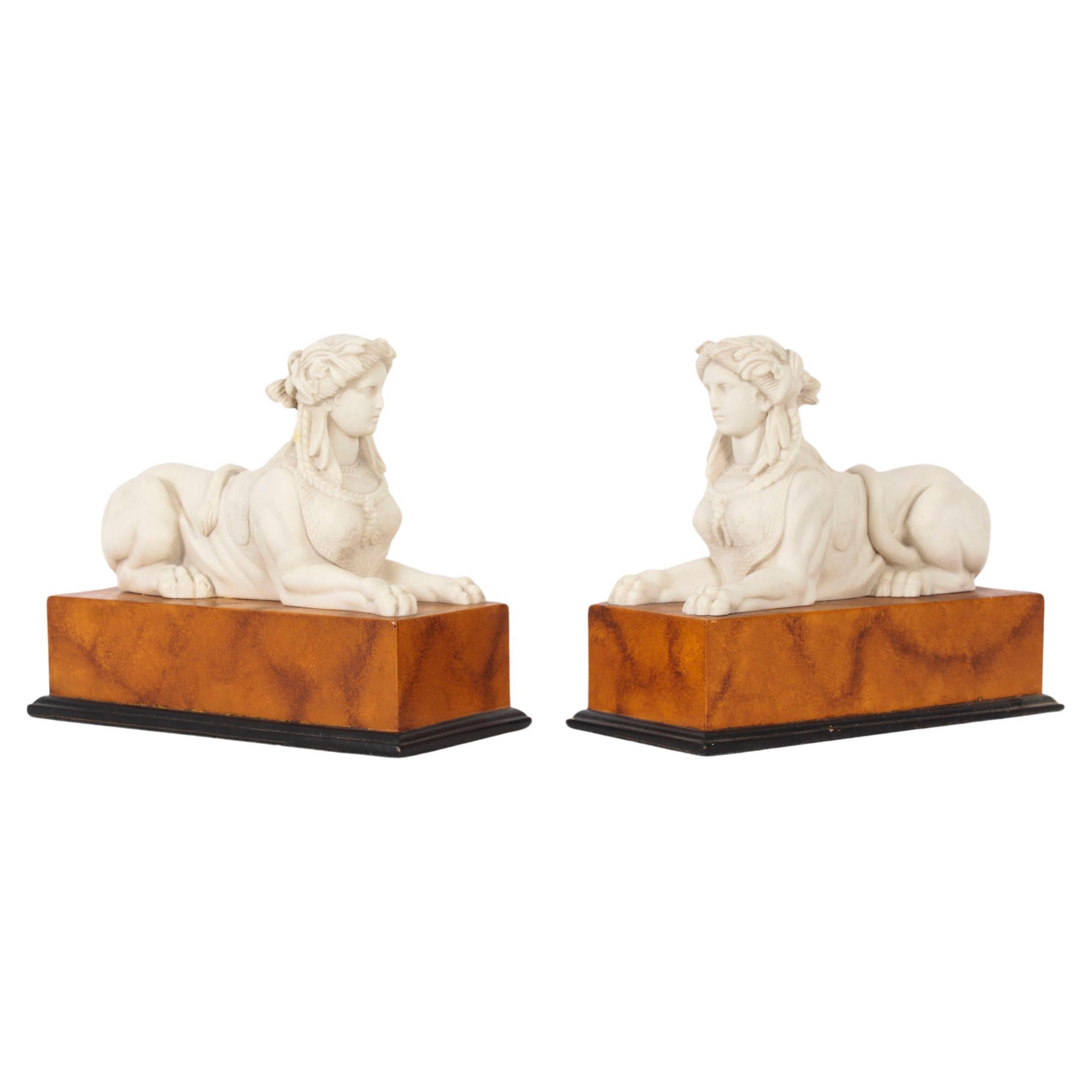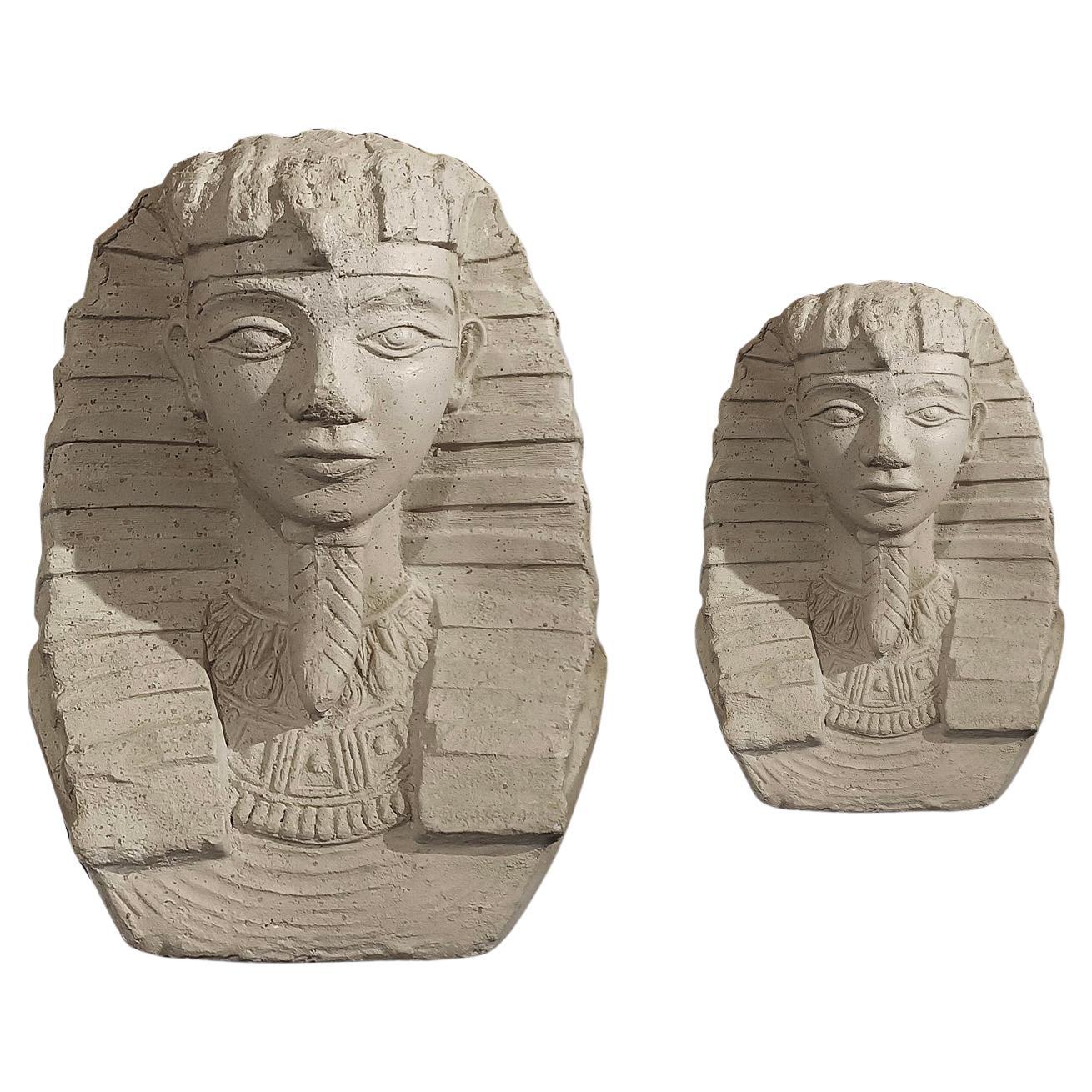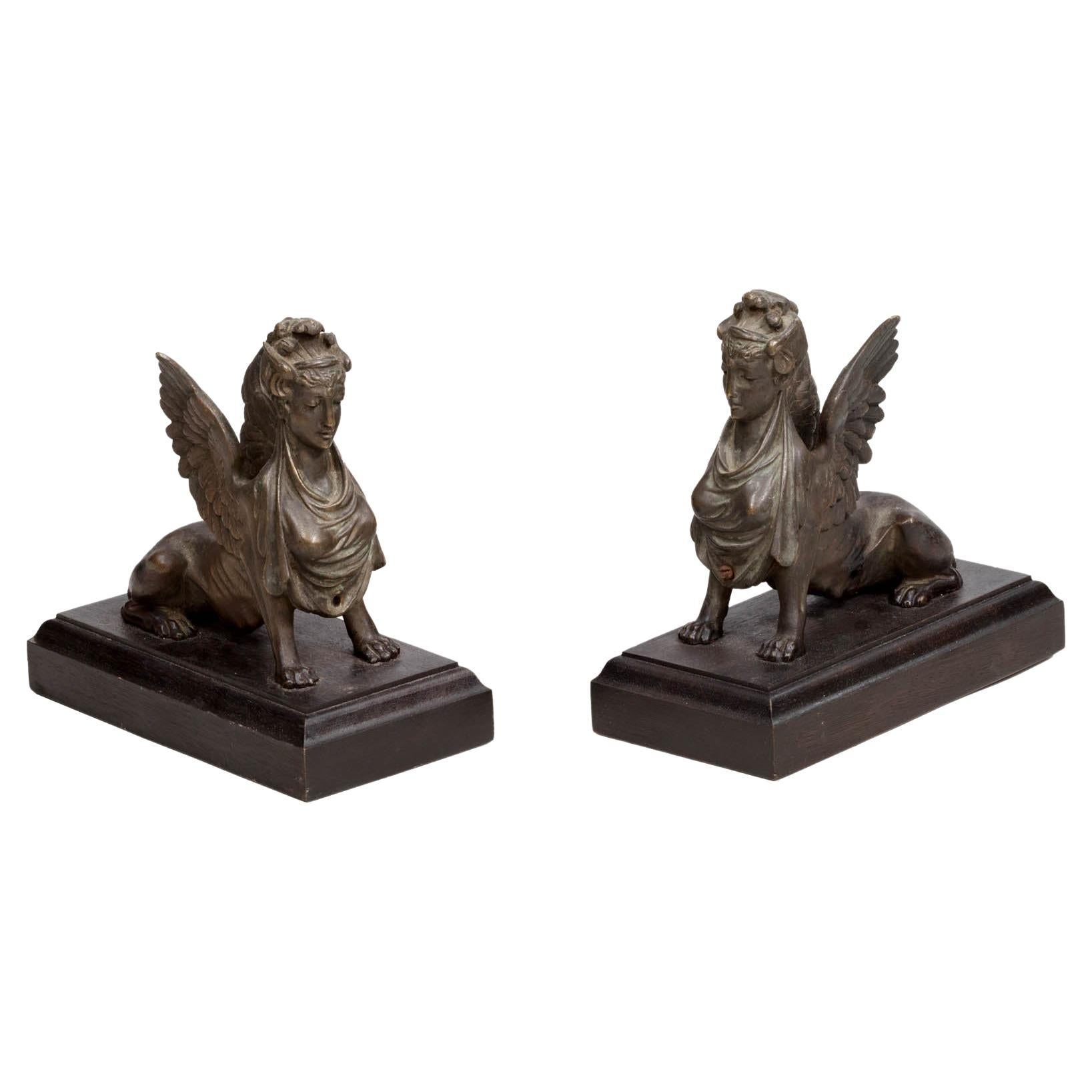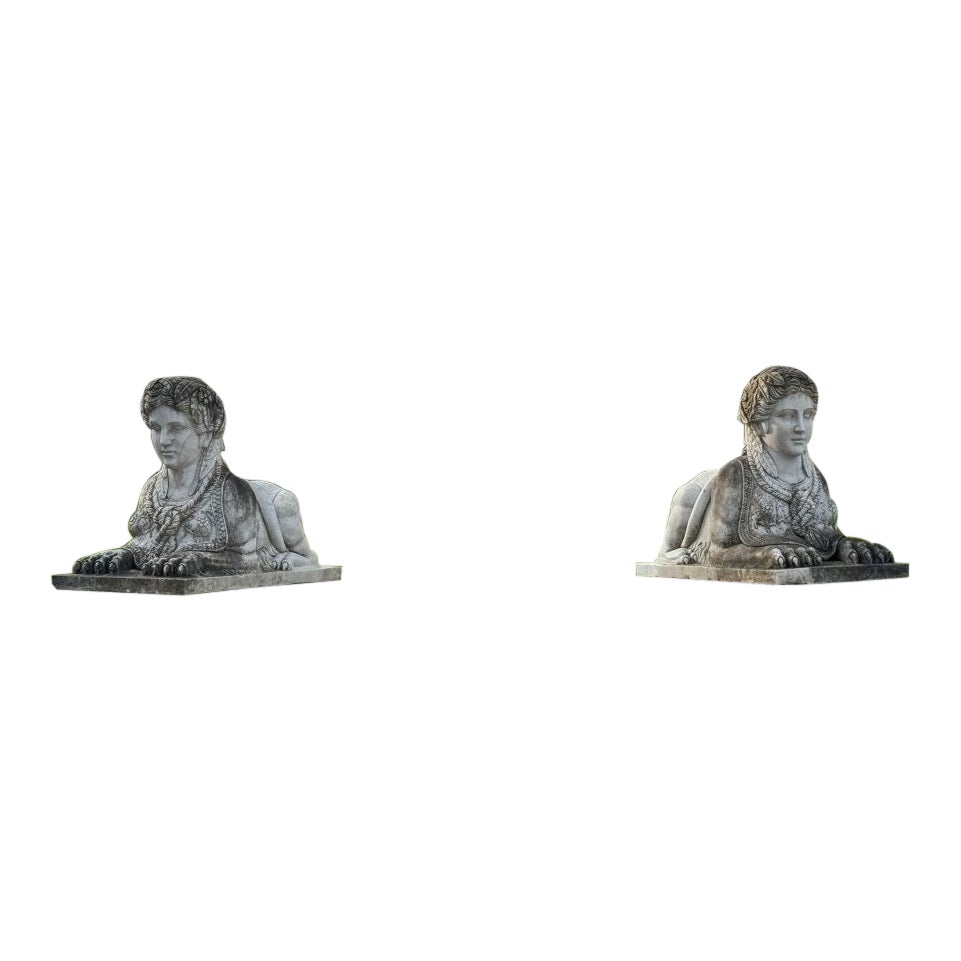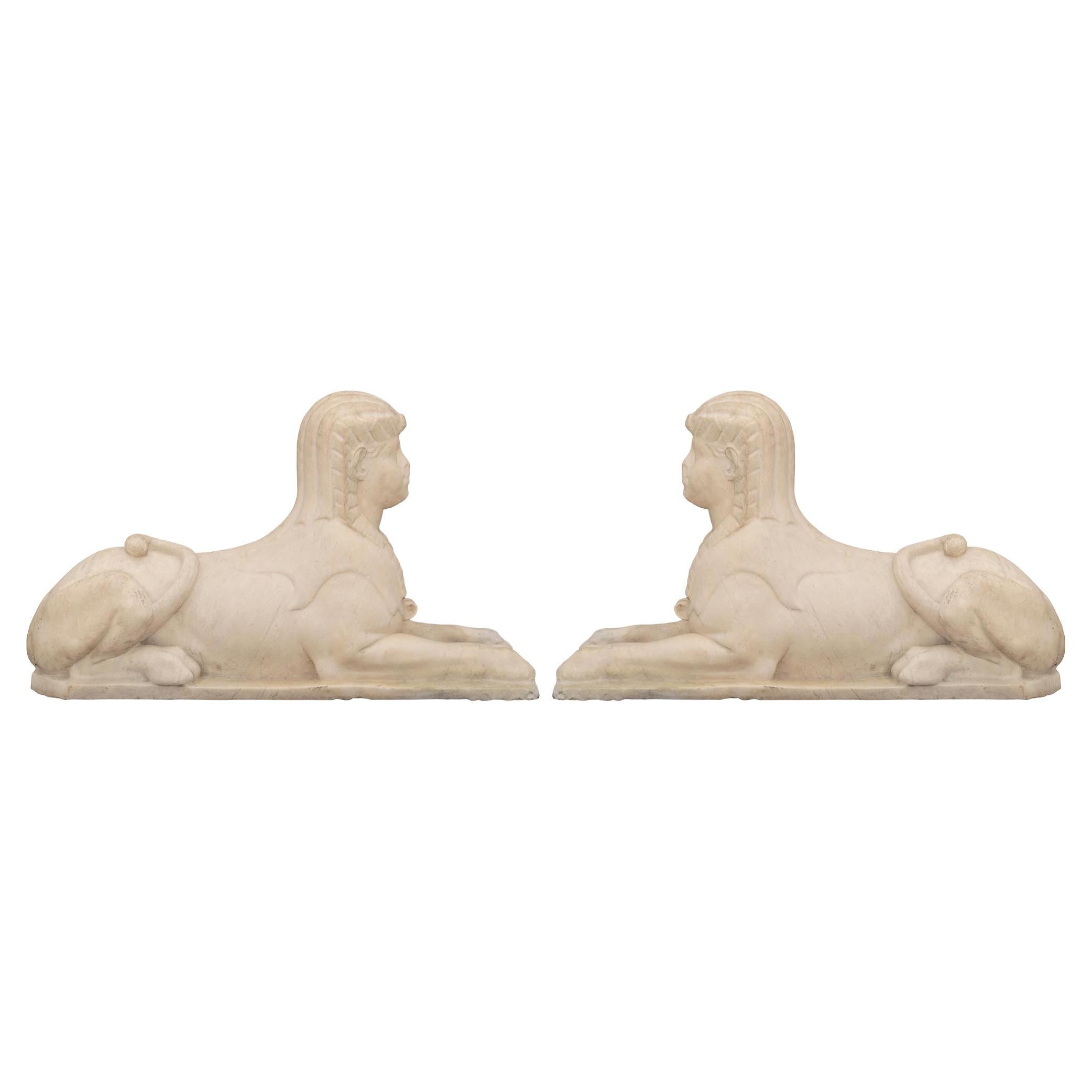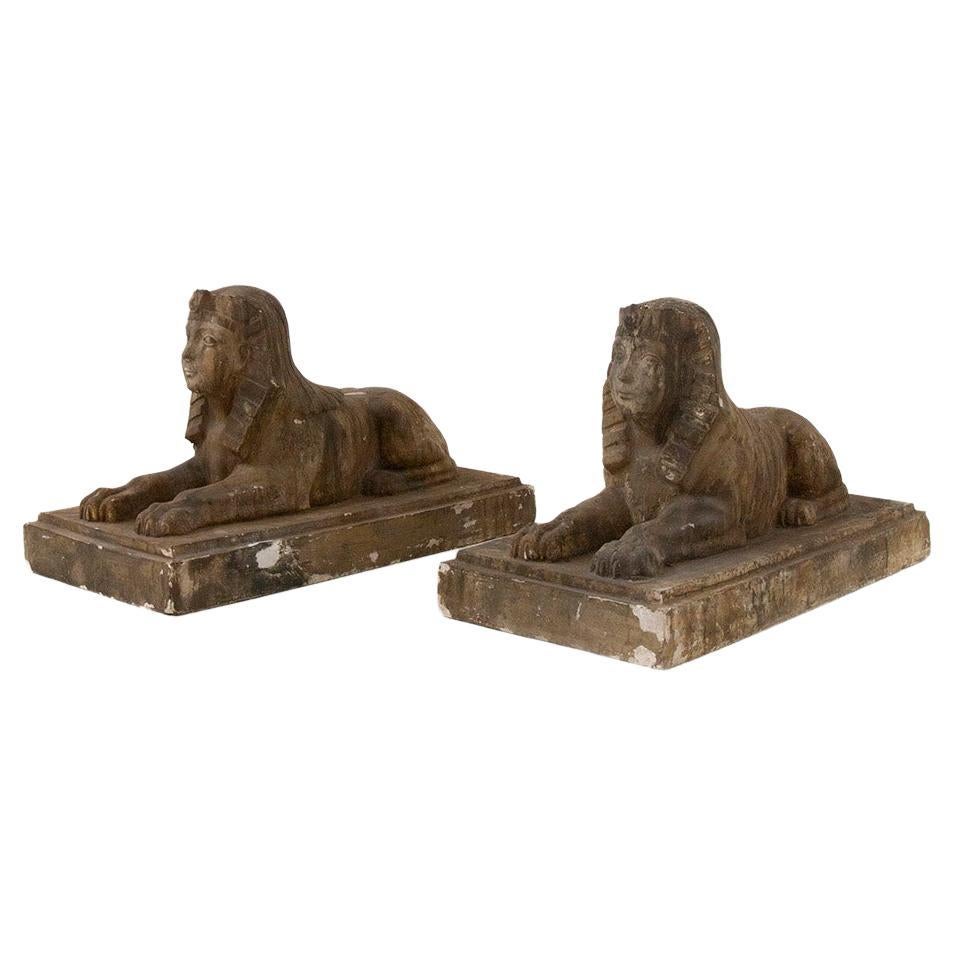Items Similar to Vintage Pair of Egyptian Recumbent Sphinxes 20th C
Want more images or videos?
Request additional images or videos from the seller
1 of 19
Vintage Pair of Egyptian Recumbent Sphinxes 20th C
About the Item
This is a beautiful Vintage pair of French composite sculptures of Egyptian recumbent Sphinx, dating from the late 20th Century.
Each sphinx is modelled wearing a pharaonic headdress on a human head with a lions body.
Both statues have a lovely black patination which is shown in all its glory, and they are mounted on faux Siena marble plinths
The Great Sphinx at Giza became a popular subject when Egyptomania swept Europe in the decades following Napoleon's military expedition to Egypt
Provenance:
House on Belgrave Square, London
Condition:
In excellent condition, please see photos for confirmation.
Dimensions in cm:
Height 15 cm x Width 19 cm x Depth 9 cm
Dimensions in inches:
Height 6 inches x Width 7 inches x Depth 3 inches
Belgrave Square
Known to be one of the most prestigious addresses in the country, Belgrave Square has been famous since it’s development in the mid 19th century, commissioned by the 2nd Earl Grosvenor, late 1st Marquess of Westminster and contracted/built by Thomas Cubitt and George Basevi respectively.
Whilst the majority of properties are now embassies or headquarters for international businesses or charities, very few remain as private houses, including this house which Bellmans have been instructed to sell the contents on behalf of the current owners.
Sphinx,
mythological creature with a lion’s body and a human head, an important image in Egyptian and Greek art and legend. The word sphinx was derived by Greek grammarians from the verb sphingein (“to bind” or “to squeeze”), but the etymology is not related to the legend and is dubious. Hesiod, the earliest Greek author to mention the creature, called it Phix.
The winged sphinx of Boeotian Thebes, the most famous in legend, was said to have terrorized the people by demanding the answer to a riddle taught her by the Muses—What is it that has one voice and yet becomes four-footed and two-footed and three-footed?—and devouring a man each time the riddle was answered incorrectly. Eventually Oedipus gave the proper answer: man, who crawls on all fours in infancy, walks on two feet when grown, and leans on a staff in old age. The sphinx thereupon killed herself. From this tale apparently grew the legend that the sphinx was omniscient, and even today the wisdom of the sphinx is proverbial.
The earliest and most famous example in art is the colossal recumbent Great Sphinx at Giza, Egypt, dating from the reign of King Khafre (4th king of 4th dynasty, c. 2575–c. 2465 BCE). This is known to be a portrait statue of the king, and the sphinx continued as a royal portrait type through most of Egyptian history. Arabs, however, know the Great Sphinx of Giza by the name of Abū al-Hawl, or “Father of Terror.”
Through Egyptian influence the sphinx became known in Asia, but its meaning there is uncertain. The sphinx did not occur in Mesopotamia until about 1500 BCE, when it was clearly imported from the Levant. In appearance the Asian sphinx differed from its Egyptian model most noticeably in the addition of wings to the leonine body, a feature that continued through its subsequent history in Asia and the Greek world. Another innovation was the female sphinx, which first began to appear in the 15th century BCE. On seals, ivories, and metalwork the sphinx was portrayed sitting on its haunches, often with one paw raised, and was frequently paired with a lion, a griffin (part eagle and part lion), or another sphinx.
About 1600 BCE the sphinx first appeared in the Greek world. Objects from Crete at the end of the middle Minoan period and from the shaft graves at Mycenae throughout the late Helladic age showed the sphinx characteristically winged. Although derived from the Asian sphinx, the Greek examples were not identical in appearance; they customarily wore a flat cap with a flame like projection on top. Nothing in their context connected them with later legend, and their meaning remains unknown.
After 1200 BCE the depiction of sphinxes disappeared from Greek art for about 400 years, though they continued in Asia in forms and poses similar to those of the Bronze Age. By the end of the 8th century, the sphinx reappeared in Greek art and was common down to the end of the 6th century. Often associated with Oriental motifs, it was clearly derived from an Eastern source, and from its appearance it could not have been a direct descendant of the Bronze Age Greek sphinx. The later Greek sphinx was almost always female and usually wore the long-tiered wig known on contemporary sculptures of the Daedalic style; the body became graceful, and the wings developed a beautiful curving form unknown in Asia. Sphinxes decorated vases, ivories, and metal works and in the late Archaic period occurred as ornaments on temples. Although their context is usually insufficient to enable their meaning to be judged, their appearance on temples suggests a protective function.
By the 5th century clear illustrations of the encounter between Oedipus and the sphinx appeared on vase paintings, usually with the sphinx perched on a column (as can be seen on a red-figure Nolan amphora by the Achilles Painter in the Museum of Fine Arts in Boston or on the Vatican Museum’s Attic cup). Other monuments of Classical age showed Oedipus in armed combat with the sphinx and suggested an earlier stage of the legend in which the contest was physical instead of mental. Of such a stage the literature gave no hint, but battles of men and monsters were common in Asian art from prehistoric times down to the Achaemenid Persians, and Greek art may have adopted from the Middle East a pictorial theme that Greek literature did not share.
Our reference: A3715a
- Dimensions:Height: 5.91 in (15 cm)Width: 7.49 in (19 cm)Depth: 3.55 in (9 cm)
- Sold As:Set of 2
- Materials and Techniques:
- Place of Origin:
- Period:
- Date of Manufacture:Circa 1980
- Condition:
- Seller Location:London, GB
- Reference Number:
About the Seller
5.0
Platinum Seller
These expertly vetted sellers are 1stDibs' most experienced sellers and are rated highest by our customers.
Established in 1983
1stDibs seller since 2012
1,199 sales on 1stDibs
Typical response time: <1 hour
Associations
LAPADA - The Association of Arts & Antiques Dealers
- ShippingRetrieving quote...Ships From: London, United Kingdom
- Return PolicyA return for this item may be initiated within 14 days of delivery.
More From This SellerView All
- Vintage Pair of Egyptian Cream Recumbent Sphinxes 20th CenturyLocated in London, GBThis is a beautiful Vintage pair of French composite sculptures of Egyptian recumbent Sphinx, dating from the late 20th Century. Each sphinx is modelled wearing a pharaonic headdre...Category
Late 20th Century Figurative Sculptures
MaterialsOther
- Vintage Pair of Bronze Verdigris Pelicans, 20th CenturyLocated in London, GBThis is a lovely Vintage pair of bronze pelicans with fabulous Verdigris patina, dating from the last quarter of the 20th century. The attention to detail is absolutely fantastic ...Category
Vintage 1980s English Animal Sculptures
MaterialsBronze
- Vintage Pair of Cast Bronze Seated Lions, 20th CenturyLocated in London, GBThis is a very interesting patinated bronze sculpture of a pair of lions, late 20th Century in date. They are sitting up proudly, with toned muscles and impressive manes. This sig...Category
Vintage 1980s Animal Sculptures
MaterialsBronze
- Vintage Pair of Stunning Carrara Marble Obelisks Mid 20th CenturyLocated in London, GBA stunning Vintage pair of large Empire Revival obelisks, dating from the late 20th Century. They are made of beautiful white Carrara marble, the finish and attention to detail thro...Category
Late 20th Century Empire Revival Abstract Sculptures
MaterialsMarble
- Vintage Bronze Sculpture of Nelson 20th CenturyLocated in London, GBA stunning bronze sculptures of one of Britain's greatest ever military heroes, dating from the late 20th Century. On 21 October 1805, the Franco-Spanish fleet came out of port and...Category
Late 20th Century Figurative Sculptures
MaterialsBronze
- Vintage Pair of Bronze Pelicans on Mooring Posts, Late 20th CenturyLocated in London, GBThis is a splendid large pair of solid bronze pelicans on mooring posts, dating from the late 20th century. This charming pair feature one pelican si...Category
Vintage 1980s Animal Sculptures
MaterialsBronze
You May Also Like
- EARLY 20th CENTURY PAIR OF STUCCO SPHINXESLocated in Firenze, FIPair of sphinxes made of patinated stucco, produced in Italy at the beginning of the 20th century. The sculptures were created following the model of archaeological finds, as was typ...Category
Early 20th Century Italian Figurative Sculptures
MaterialsStucco
- 19th Century Pair of Bronze Egyptian Revival SphinxLocated in Dublin 8, IE19th century pair of bronze Egyptian Revival sphinx figures in reclining poses seated on solid wooden rectangular plinth bases. A well-detailed...Category
Antique 19th Century European Grand Tour Animal Sculptures
MaterialsBronze
- Imposing Pair Of Sphinxes In White Marble 20th CenturyLocated in Honnelles, WHTPair Of Sphinges In White Marble, Very Beautiful PatinaCategory
20th Century European Greco Roman Figurative Sculptures
MaterialsMarble
- Pair of Italian 19th Century Neoclassical Style Marble Egyptian SphinxesLocated in West Palm Beach, FLAn impressive pair of Italian 19th century Neo-Classical st. white Carrara marble statues of Egyptian Sphinxes. Each Sphinx is sculpted out of one solid piece of marble and is raised...Category
Antique 19th Century Italian Neoclassical Figurative Sculptures
MaterialsMarble
- Pair of Egyptian sphinxes in gold-coloured scaiola plasterLocated in Milano, ITDiscover the epitome of elegance with this exquisite pair of Egyptian sphinx statues. Crafted with meticulous attention to detail, these magnificent sculptures are made of scaiola pl...Category
Antique 1880s French Egyptian Animal Sculptures
MaterialsPlaster
- Ancient Egyptian Monumental Temple SphinxesLocated in London, GBA pair of monumental limestone sphinxes of Pharaoh Nectanebo I, from the processional avenue of the Serapeum of Memphis, 30th Dynasty, circa 379 - 360 BC. The sphinxes of the Serapeum have captivated travellers since Roman times. However, despite their significance, they are conspicuously absent from the collections of most major museums. Indeed, their existence in private hands is so improbable, and their imitations so numerous, that the present sphinxes were assumed to be modern copies throughout their recent ownership history. Finally recognised and conserved after an extraordinary chance discovery at a garden furniture sale...Category
Antique 15th Century and Earlier Egyptian Egyptian Figurative Sculptures
MaterialsLimestone
